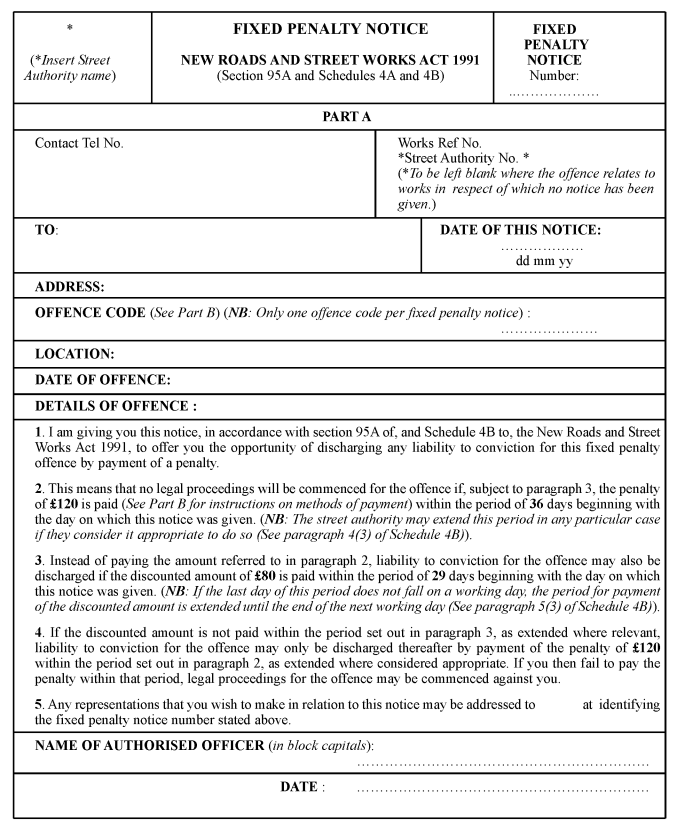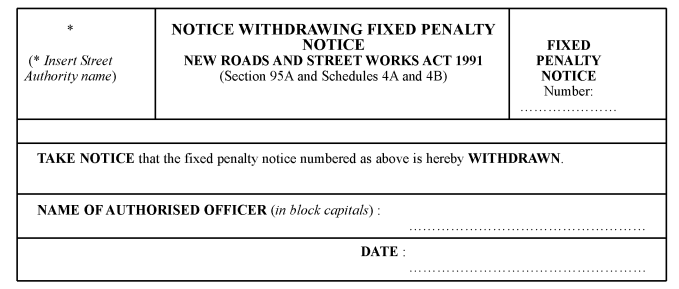The Street Works (Fixed Penalty) (Wales) Regulations 2008
Title, commencement and application1.
The title of these Regulations is the Street Works (Fixed Penalty) (Wales) Regulations 2008. They come into force on 12th May 2008 and apply in relation to Wales.
Interpretation2.
In these Regulations—
“the 1991 Act” means the New Roads and Street Works Act 1991;
“address”, in relation to a particular method for transmitting an electronic communication, means any number or address used for the purposes of such method of transmission;
“offence” means a fixed penalty offence.
Exceptions3.
Section 95A(1) of, and Schedule 4A to, the 1991 Act (fixed penalty offences under Part 3) do not apply to a street which is not a maintainable highway.
Form of fixed penalty notice4.
A fixed penalty notice must be in the form set out in Schedule 1.
Manner of service of a fixed penalty notice or a notice withdrawing a fixed penalty notice5.
(1)
Subject to paragraphs (5) and (7), where a person—
(a)
has provided a street authority with an address for service on him or her of any notice under Schedule 4B to the 1991 Act (fixed penalties for certain offences under Part 3) by using a particular method for transmitting an electronic communication; and
(b)
has not notified the authority that the address is withdrawn for that purpose,
such notice must be given by sending it to him or her at that address by that method, in accordance with the condition set out in paragraph (3).
(2)
In any other case, a notice under that Schedule must be given by—
(a)
sending it by first class post to the person to whom it is to be given at his or her proper address;
(b)
delivering it to him or her;
(c)
leaving it at his or her proper address; or
(d)
any other means agreed with him or her.
(3)
The condition referred to in paragraph (1) is that the notice must be—
(a)
capable of being accessed by the person to whom it is being sent;
(b)
legible in all material respects; and
(c)
in a form which permits the notice to be retained for subsequent reference,
and for this purpose “legible in all material respects” means that the information contained in the notice is available to that person to no lesser extent than it would be if given by means of a notice in printed form.
(4)
Subject to section 98(2) of the 1991 Act (reckoning of periods), where an electronic communication is used for the purpose of serving a notice under Schedule 4B to that Act, then, unless the contrary is proved, the notice will be deemed to be given on the day and at the time recorded by the transmitting apparatus as being the day and time of satisfactory completion of the transmission.
(5)
Where, after three attempts (duly recorded by the person serving the notice) to effect service by using one particular method for transmitting an electronic communication, service cannot be effected, the notice may be given by serving it upon the person to whom it is to be given by any other such method for which an address is available by virtue of paragraph (1) or by any of the other means referred to in paragraph (2).
(6)
Subject to paragraph (7), for the purposes of this regulation, the proper address of any person to whom a notice under Schedule 4B to the 1991 Act is to be given, is to be—
(a)
where such person has provided the street authority giving the notice with an address for postal service of such notices, that address; and
(b)
otherwise—
(i)
in the case of a corporation, the registered or principal office of the corporation; and
(ii)
in any other case, the last known address of such person.
(7)
A person may provide different addresses for different notices or different classes of notice.
Time limit for giving fixed penalty notice6.
A fixed penalty notice for an offence may not be given more than 91 days after the commission of the offence beginning with the day of its commission.
Amount of penalty7.
(1)
Subject to paragraph (2), where a fixed penalty notice has been given in relation to an offence set out in column 2 of the Table in Schedule 2 to these Regulations, and briefly described in column 3 of that Table, the penalty for that offence will be the amount set out, in relation to it, in column 4.
(2)
Where, in relation to such an offence, payment is made before the end of the period specified in paragraph 5(1) of Schedule 4B to the 1991 Act, or if the last day of that period does not fall on a working day, before the end of the next working day in accordance with paragraph 5(3) of that Schedule, the penalty for that offence will instead be the amount set out, in relation to it, in column 5.
Modification of Schedule 4B8.
(1)
Schedule 4B to the 1991 Act is modified (in its application as respects Wales) as follows.
(2)
In paragraph 4(2) for “29” substitute “36”.
(3)
In paragraph 5(1) for “15” substitute “29”.
Application of penalties9.
A street authority may deduct from fixed penalties received under Schedule 4B to the 1991 Act, the reasonable costs of operating the scheme under which they are paid, and must apply the net proceeds for the purpose of developing or implementing policies for the promotion and encouragement of safe, integrated, efficient and economic transport facilities and services to, from and within their area.
Form of notice withdrawing a fixed penalty notice10.
Where a notice withdrawing a fixed penalty notice is given in accordance with paragraph 7(1) of Schedule 4B to the 1991 Act, it must be in the form set out in Schedule 3.
SCHEDULE 1FORM OF FIXED PENALTY NOTICE
SCHEDULE 2AMOUNT OF PENALTY
(1) | (2) | (3) | (4) | (5) |
|---|---|---|---|---|
Item No. | Offence under the 1991 Act | Brief description | Amount of penalty | Discounted amount |
1. | An offence under section 54(5). | Failure to comply with duties under s.54 (advance notice of certain works, etc.). | £120. | £80. |
2. | An offence under section 55(5). | Beginning to execute works in contravention of s.55 (notice of starting date). | £120. | £80. |
3. | An offence under section 55(9)4. | Failure to give notice in accordance with s.55(8) (notice to be given on s.55 notice ceasing to have effect). | £120. | £80. |
4. | An offence under section 57(4). | Failure to give notice in accordance with s.57 (notice of emergency works). | £120. | £80. |
5. | An offence under section 70(6) consisting of a failure to comply with subsection (3) or (4A)5. | Failure to comply with requirements to give notice of completion of reinstatement. | £120. | £80. |
6. | An offence created by regulations made under section 74(7B). | Failure to give a notice required by regulations under s.74 (charge for occupation of the highway where works unreasonably delayed). | £120. | £80. |
SCHEDULE 3FORM OF NOTICE WITHDRAWING A FIXED PENALTY NOTICE
Section 41 of, and Schedules 2 and 3 to, the Traffic Management Act 2004, insert section 95A and Schedules 4A and 4B into the New Roads and Street Works Act 1991 (“the 1991 Act”). This provides for certain offences under Part 3 of the 1991 Act to become fixed penalty offences and enables regulations to be made in relation to them.
The Street Works (Fixed Penalty) (Wales) Regulations 2008 make general provision as respects Wales in relation to fixed penalties for certain offences under Part 3 of the 1991 Act.
Regulation 2 defines terms used in these Regulations.
Regulation 3 prevents street managers (the street authority for a street which is not a maintainable highway) from giving fixed penalty notices in relation to such a street.
Regulation 4 and Schedule 1 prescribe the form of a fixed penalty notice.
Regulation 5 sets out the manner of service of a fixed penalty notice and a notice withdrawing a fixed penalty notice, and includes provision for service by electronic communication.
Regulation 6 specifies that a fixed penalty notice may not be given more than 91 days after the commission of the offence, beginning with the day of its commission.
Regulation 7 and Schedule 2 set out details of the fixed penalty offences and prescribe that in relation to each offence, the penalty will be £120 unless the sum of £80 is paid before the end of the period for payment of the discounted amount.
Regulation 8 modifies Schedule 4B to the 1991 Act (in its application as respects Wales) by substituting the period of 36 days for the period of 29 days, being the period for payment of a fixed penalty, and by substituting the period of 29 days for the period of 15 days, being the period for payment of a discounted amount instead of the full penalty.
Regulation 9 enables a street authority to deduct the costs of issuing and administering fixed penalty notices from the penalties received, and requires any net proceeds to be applied to the development or implementation of certain transport policies in relation to their area.
Regulation 10 and Schedule 3 prescribe the form of a notice withdrawing a fixed penalty notice.
A full Regulatory Impact Assessment and Explanatory Memorandum can be obtained from Roads Network Management Division, Transport Wales, Welsh Assembly Government, Crown Offices, Cathays Park, Cardiff, CF10 3NQ or on the Welsh Assembly Government website at http://www.assemblywales.org/bus-home/buslegislation/bus/bus-legislation-sub/bus-legislation-sub-annulment.htm


